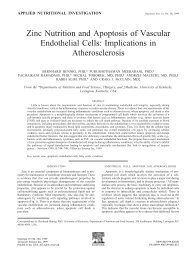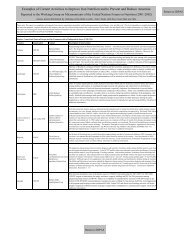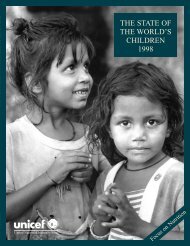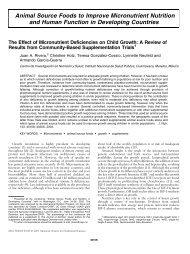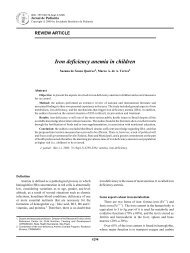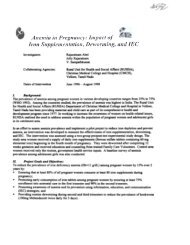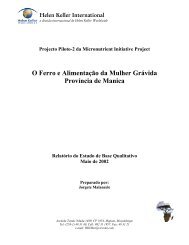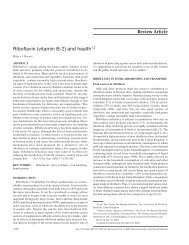Prevalence of IDA in pregnancy - Idpas.org
Prevalence of IDA in pregnancy - Idpas.org
Prevalence of IDA in pregnancy - Idpas.org
Create successful ePaper yourself
Turn your PDF publications into a flip-book with our unique Google optimized e-Paper software.
<strong>Prevalence</strong> <strong>of</strong> <strong>IDA</strong> <strong>in</strong> <strong>pregnancy</strong><br />
L<strong>in</strong>dsay H. Allen<br />
Program <strong>in</strong> International Nutrition<br />
University <strong>of</strong> California, Davis
PREVALENCE OF ANEMIA IN WOMEN, 1988<br />
WHO, 1992<br />
Non-Pregnant<br />
Pregnant<br />
% Women with low Hb<br />
World Dev'p<strong>in</strong>g Dev'pd Africa Asia Lat Amer Oceania
Trends <strong>in</strong> the <strong>Prevalence</strong> <strong>of</strong><br />
Anemia Dur<strong>in</strong>g Pregnancy<br />
3rd Trimester<br />
2nd Trimester<br />
1st Trimester<br />
Pregnancy Nutrition<br />
Surveillance System
Uncerta<strong>in</strong>ties about iron<br />
deficiency assessment <strong>in</strong><br />
<strong>pregnancy</strong>
Anemia and Indicators <strong>of</strong> Iron Status<br />
dur<strong>in</strong>g Pregnancy<br />
• Hb concentration is U-shaped, and cut-<strong>of</strong>f not<br />
well established.
Hb concentration at 28 wk associated<br />
with best outcome <strong>in</strong> large surveys<br />
Study<br />
Hb level for best outcome<br />
N<br />
LBW<br />
Preterm<br />
Mortality<br />
NCPP-<br />
USA<br />
60,000<br />
102-125<br />
112-125<br />
95-105<br />
Cardiff<br />
55,000<br />
104-132<br />
-<br />
104-132<br />
NW<br />
Thames<br />
>150,000<br />
96-105<br />
(86-95 BW)<br />
96-105
Anemia and Indicators <strong>of</strong> Iron Status<br />
dur<strong>in</strong>g Pregnancy<br />
• Hemodilution alters iron status <strong>in</strong>dicators (Hb,<br />
ferrit<strong>in</strong>, transferr<strong>in</strong> saturation).<br />
• Better to use TfR, RBC protoporphyr<strong>in</strong> or RBC<br />
ferrit<strong>in</strong>?
Serum TfRs <strong>in</strong> pregnant Swedish women….<br />
Akesson et al., Am. J. Cl<strong>in</strong>. Nutr. 1998<br />
Low Hb<br />
Low ferrit<strong>in</strong><br />
↑ TfR<br />
All 3<br />
abnormal<br />
Trimester 1<br />
1<br />
10<br />
0<br />
0<br />
Trimester 3<br />
7<br />
58<br />
14<br />
5
Transferr<strong>in</strong> receptors <strong>in</strong> <strong>pregnancy</strong><br />
• In US, 63/81 women with low ferrit<strong>in</strong> <strong>in</strong> trimester 3 had<br />
normal TfR values.<br />
• But all with low ferrit<strong>in</strong> had elevated TfR.<br />
• Many more women have depleted stores than depleted<br />
tissue iron.<br />
• In Jamaica, TfR best differentiated Fe-supplemented from<br />
placebo group <strong>in</strong> late <strong>pregnancy</strong>. Iron prevented <strong>in</strong>crease <strong>in</strong><br />
TfR.
Supplements can improve<br />
maternal and <strong>in</strong>fant iron status
100 mg/d Fe Improved Infant Serum Ferrit<strong>in</strong><br />
120<br />
100<br />
80<br />
*<br />
* P < 0.05<br />
60<br />
40<br />
20<br />
0<br />
*<br />
Birth 3 mo 6 mo<br />
Placebo<br />
Fe Suppl
Studies <strong>in</strong> Which Maternal Iron Status<br />
Was Related to Mother’s Status<br />
Obs or SupplHb Ferrit<strong>in</strong> Comment<br />
Agrawal India O No Yes<br />
Ajayi Nigeria O (Yes) Yes<br />
Lao Ch<strong>in</strong>a O (No) (No)<br />
Gaspar Spa<strong>in</strong> O Yes Yes<br />
Kaneshige Japan O ? Yes<br />
Hokoma Japan O No Yes<br />
DeBenaze France S No Yes & 2 mo<br />
Milman Denmark S No Yes<br />
Colomer Spa<strong>in</strong> O Yes & 12 mo
Iron supplementation <strong>in</strong><br />
<strong>pregnancy</strong> reduces risk <strong>of</strong><br />
postpartum <strong>IDA</strong>
Postpartum Anemia is a Major Problem<br />
• In the United States, <strong>of</strong> ≈59,000 women <strong>in</strong> the<br />
Women, Infants and Childrens Program:<br />
Postpartum anemia occurred <strong>in</strong><br />
• 27% <strong>of</strong> all women<br />
• 48% <strong>of</strong> Black women<br />
• 21% <strong>of</strong> those non-anemic <strong>in</strong> Trimester 3<br />
• 49% <strong>of</strong> those with anemia <strong>in</strong> Trimester 3
100 mg/d Fe reduced % anemia <strong>in</strong> Tanzanian women 1<br />
Preziosi et al. 1997.<br />
%<br />
80<br />
70<br />
60<br />
50<br />
40<br />
30<br />
20<br />
10<br />
0<br />
*<br />
6 mo pg term 3 mo pp 6 mo pp<br />
*<br />
Placebo<br />
Fe Suppl<br />
* P
Maternal <strong>IDA</strong> <strong>in</strong>creases risk <strong>of</strong><br />
poor <strong>pregnancy</strong> outcomes
Non-<strong>in</strong>tervention Studies:<br />
Anemia and Relative Risk <strong>of</strong> Poor Outcomes<br />
Moderate<br />
anemia<br />
Severe anemia<br />
<strong>IDA</strong> - USA<br />
-PNG<br />
Low birthweight<br />
0.8 – 3.0<br />
1.0 – 6.3<br />
3.1<br />
6.0 (early only)<br />
Preterm<br />
0.6 – 3.2<br />
0.6 – 4.0<br />
2.7<br />
-
Conclusions: maternal mortality from anemia<br />
• Relative risk = 1.35 for Hb 40-80 g/L, and<br />
3.51 for Hb
Recent Intervention Trial Shows Effect <strong>of</strong><br />
Iron Supplements on Birthweight<br />
• Importantly, for ethical reasons there has been<br />
lack <strong>of</strong> RCTs (placebo group).<br />
• But IOM says <strong>in</strong>tervention may only be needed if<br />
Hb 20<br />
ug/L) women <strong>in</strong> Ohio. (45% <strong>of</strong> those screened).<br />
• 30 mg Fe/d from wk. 16 – 20 through wk. 28.<br />
• If Hb
Risk <strong>of</strong> Adverse Birth Outcomes for Non-Anemic,<br />
Iron-Replete Women is Reduced by Iron<br />
Supplements for 2-3 Months (Cogswell et al. 2002)<br />
Outcome<br />
+ Iron<br />
Placebo<br />
Difference<br />
Birth wt<br />
3277<br />
3072<br />
206**<br />
% low BW<br />
4.3<br />
16.7<br />
-12.4***<br />
Gest. age (wk)<br />
38.9<br />
38.3<br />
0.6*<br />
% preterm<br />
12.8<br />
12.5<br />
ns<br />
% SGA<br />
6.8<br />
17.7<br />
-10.9*
Maternal CRH <strong>in</strong> pre-term, term, & post-term deliveries<br />
McLean et al., 1995
Iron supplementation <strong>in</strong> <strong>pregnancy</strong> –<br />
what we have learned<br />
• ↑ Hb and ferrit<strong>in</strong> <strong>in</strong> late <strong>pregnancy</strong> <strong>in</strong> many women - <strong>IDA</strong><br />
or non-<strong>IDA</strong> early <strong>in</strong> gestation.<br />
• ↑ maternal Fe status for up to 6 mo postpartum.<br />
• ↑ birthweight ( ↓ preterm?).<br />
• ↑ <strong>in</strong>fant Fe stores for many months.<br />
• May improve maternal care-tak<strong>in</strong>g postpartum.<br />
• Weekly supplementation works, daily more effective.<br />
• Hb <strong>in</strong>crease is proportional to total amount <strong>of</strong> Fe<br />
consumed.<br />
• Optimal time to start supplements is uncerta<strong>in</strong> but even<br />
relatively late can improve maternal and <strong>in</strong>fant Fe status <strong>in</strong><br />
gestation and postpartum . Earlier to improve BW?
Impact <strong>of</strong> birth weight on iron<br />
status<br />
L<strong>in</strong>dsay H. Allen<br />
Program <strong>in</strong> International Nutrition<br />
University <strong>of</strong> California, Davis
How does birthweight affect<br />
iron stores at birth?<br />
• Dallman (1974); iron stores at birth are<br />
approximately proportional to body weight.<br />
• LBW <strong>in</strong>fants also grow faster.<br />
• So LBW <strong>in</strong>fants deplete stores at 2-4<br />
months (vs. 4-6 months).<br />
• LBW <strong>in</strong>fants need iron supplements or ironfortified<br />
food.
Guidel<strong>in</strong>es for Iron Supplementation<br />
(INACG/WHO/UNICEF, 1998)<br />
• Where the prevalence <strong>of</strong> anemia is 20-40%,<br />
– For <strong>in</strong>fants age 6-24 mo give 12.5 mg Fe/d + 50<br />
ug folic acid, start<strong>in</strong>g at 6 mo and cont<strong>in</strong>u<strong>in</strong>g<br />
until 24 mo if possible, if not until 12 mo.<br />
– For LBW <strong>in</strong>fants, start at 2 mo.<br />
• Where the prevalence <strong>of</strong> anemia is >40%,<br />
– Cont<strong>in</strong>ue supplementation until 24 mo.
Guidel<strong>in</strong>es for Iron Supplementation<br />
(INACG/WHO/UNICEF, 1998)<br />
Age Dose (mg) Birth Wt Duration<br />
6-24 mo 12.5 + FA Normal 6-12 mo<br />
LBW 2-12 mo<br />
2-5 y 20-30<br />
6-11 30-60<br />
Adol/adult 60<br />
Preg 60 + FA 6 mo<br />
Preg, high<br />
prevalence<br />
60 + FA 6 mo + 3<br />
mo lact<br />
Dose is doubled for 3 mo if severe anemia (
• Honduran <strong>in</strong>fants<br />
Dewey et al. 1999<br />
• 50% <strong>of</strong> LBW <strong>in</strong>fants had Hb
Low birthweight vs. risk <strong>of</strong> <strong>in</strong>fant<br />
anemia at 4.5 mo<br />
de Pee et al. 2002<br />
Maternal Hb and<br />
birthweight<br />
≥120 g/L, >2500 g<br />
≥120 g/L, ≤2500 g<br />
2500 g<br />
>120 g/L, ≤2500 g<br />
% Hb
How can guidel<strong>in</strong>es be improved?<br />
• Is it reasonable to cont<strong>in</strong>ue longer <strong>in</strong> areas<br />
where prevalence <strong>of</strong> anemia is higher?<br />
• When supplements stop, how long does<br />
depletion take?<br />
• Is
Improv<strong>in</strong>g strategies for supplementation<br />
<strong>of</strong> pregnant and lactat<strong>in</strong>g women
1. Be more specific about<br />
number <strong>of</strong> tablets women need<br />
to take. (Frequency <strong>of</strong><br />
consumption less important?)
Weekly dos<strong>in</strong>g <strong>in</strong> at least some<br />
situations?
2. M<strong>in</strong>imize Side Effects<br />
• “There is little evidence that side effects are the<br />
major cause <strong>of</strong> non-compliance” (Galloway,<br />
1994).<br />
• Blot, Simmons, IOM 2000<br />
• with 65 mg x 3, 25% symptoms vs 13% placebo<br />
• with 130 x 3<br />
40% symptoms<br />
• “unlikely that 60 mg x 2 would affect compliance”<br />
IOM 1993
Side Effects: IOM Report, 2001<br />
• High dose supplements associated with constipation, nausea,<br />
vomit<strong>in</strong>g, diarrhea<br />
• Less effect at lower dose, with food, slow release<br />
• “Lower Observed Adverse Effect Level” = 60 mg/d suppl + 11 mg<br />
diet = 71 mg/d, and<br />
• “No Observed Adverse Effect Level” = “Upper Limit” = 45 mg/d<br />
“Critical<br />
Study”<br />
Effect<br />
Nausea<br />
Placebo<br />
4<br />
60 mg Fe<br />
6<br />
Gastric pa<strong>in</strong><br />
10<br />
19<br />
Constipation<br />
20<br />
35*<br />
Diarrhea<br />
19<br />
37<br />
All effects<br />
14<br />
25*
Unanswered Questions<br />
• How much supplemental iron is needed to improved<br />
<strong>pregnancy</strong> outcomes <strong>in</strong> <strong>IDA</strong> women?<br />
• What are the norms for iron status <strong>in</strong>dicators <strong>in</strong> <strong>pregnancy</strong>?<br />
• Is there a risk <strong>of</strong> excessive iron <strong>in</strong>take? What are the risks?<br />
• When is the best time to beg<strong>in</strong> iron supplementation for<br />
improv<strong>in</strong>g outcomes <strong>in</strong> anemic women?<br />
• What is the expected impact on maternal and <strong>in</strong>fant iron<br />
status when supplements are given to anemic women prior<br />
to and/or dur<strong>in</strong>g <strong>pregnancy</strong>?
Possible Biological Mechanisms
Similarities and Differences Between Risk<br />
Factors for IUGR and Preterm Delivery<br />
• “The degree <strong>of</strong> overlap between the sets<br />
<strong>of</strong> risk factors for preterm delivery and<br />
IUGR is so great that it is easiest to list<br />
the discrepancies”……<br />
(Yu and Wood, 1987)
Placental Iron Transfer<br />
• Fe transport via transferr<strong>in</strong> receptors and<br />
ferrit<strong>in</strong> receptors on placental trophoblasts.<br />
• Liao et al. 2001, placental Fe transfer:<br />
- If Fe adequate, placental Fe transport via TfR<br />
and FnR<br />
- In mild ID/A, › #TfR and #FnR, but fl TS<br />
- In severe ID/A, no further › receptor #s and<br />
also low TS and low ferrit<strong>in</strong>.
Normal hemoglob<strong>in</strong> values dur<strong>in</strong>g <strong>pregnancy</strong>
Change <strong>in</strong> hemoglob<strong>in</strong> and serum<br />
ferrit<strong>in</strong> after 10 weeks <strong>of</strong><br />
supplementation <strong>in</strong> anemic pregnant<br />
18<br />
16<br />
14<br />
12<br />
10<br />
8<br />
6<br />
4<br />
2<br />
0<br />
Hb, g/L<br />
*<br />
women<br />
*<br />
Ferrit<strong>in</strong>, ug/L<br />
* P
Iron Status <strong>in</strong> Trimester I Predicts Low Birth<br />
Weight and Prematurity (New Jersey USA)<br />
LBW<br />
Preterm<br />
50<br />
40<br />
30<br />
20<br />
10<br />
0<br />
Anemia<br />
<strong>IDA</strong><br />
Other Anemia<br />
No Anemia<br />
Scholl, Am. J. Cl<strong>in</strong>. Nutr. 1992
Anemia and Indicators <strong>of</strong> Iron Status<br />
dur<strong>in</strong>g Pregnancy<br />
• Hb concentration is U-shaped, and cut-<strong>of</strong>f not well<br />
established.<br />
• Hemodilution alters iron status <strong>in</strong>dicators (Hb, ferrit<strong>in</strong>,<br />
transferr<strong>in</strong> saturation; better to use TfR, RBC<br />
protoporphyr<strong>in</strong> or RBC ferrit<strong>in</strong>?).<br />
• Maternal iron status does not alter the pattern <strong>of</strong><br />
changes, but it directly <strong>in</strong>fluences absolute values<br />
• Hb concentrations <strong>in</strong> third trimester<br />
– unsupplemented women: 10.5-11.0 g/dL<br />
– supplemented women: ~ 1 g/dL greater
Attribut<strong>in</strong>g Mortality to Anemia<br />
is Difficult<br />
• Usually hospital data, from moribund women.<br />
• Anemia <strong>of</strong>ten not reported, or is 1 cause <strong>of</strong><br />
death.<br />
• Confounders (<strong>in</strong>fection, hemorrhage, malaria).<br />
• No RCT with Fe because ethically difficult, and<br />
transfusion used if anemic near term.
Maternal Mortality Due to Anemia (WHO)<br />
Region<br />
All cause deaths<br />
/100,000<br />
% attributed<br />
to anemia<br />
Africa<br />
Asia<br />
Lat<strong>in</strong><br />
America<br />
640<br />
420<br />
270<br />
6.4<br />
7.3<br />
3.0
Conclusions from Meta-Analysis <strong>of</strong> Daily<br />
or Weekly Supplementation<br />
Beaton & McCabe, 1999<br />
• BOTH daily and weekly reduced <strong>IDA</strong><br />
• Daily more efficacious to › Hb and ferrit<strong>in</strong>;<br />
daily caused 2 g/L higher Hb and 34% lower risk<br />
anemia. Relative efficacy did not vary by<br />
group.<br />
• Weekly may be more effective when<br />
supervision feasible with weekly but not with<br />
daily.<br />
• Many studies had high prevalence <strong>of</strong> anemia<br />
AFTER <strong>in</strong>tervention, even with daily -<br />
compliance a likely explanation.




